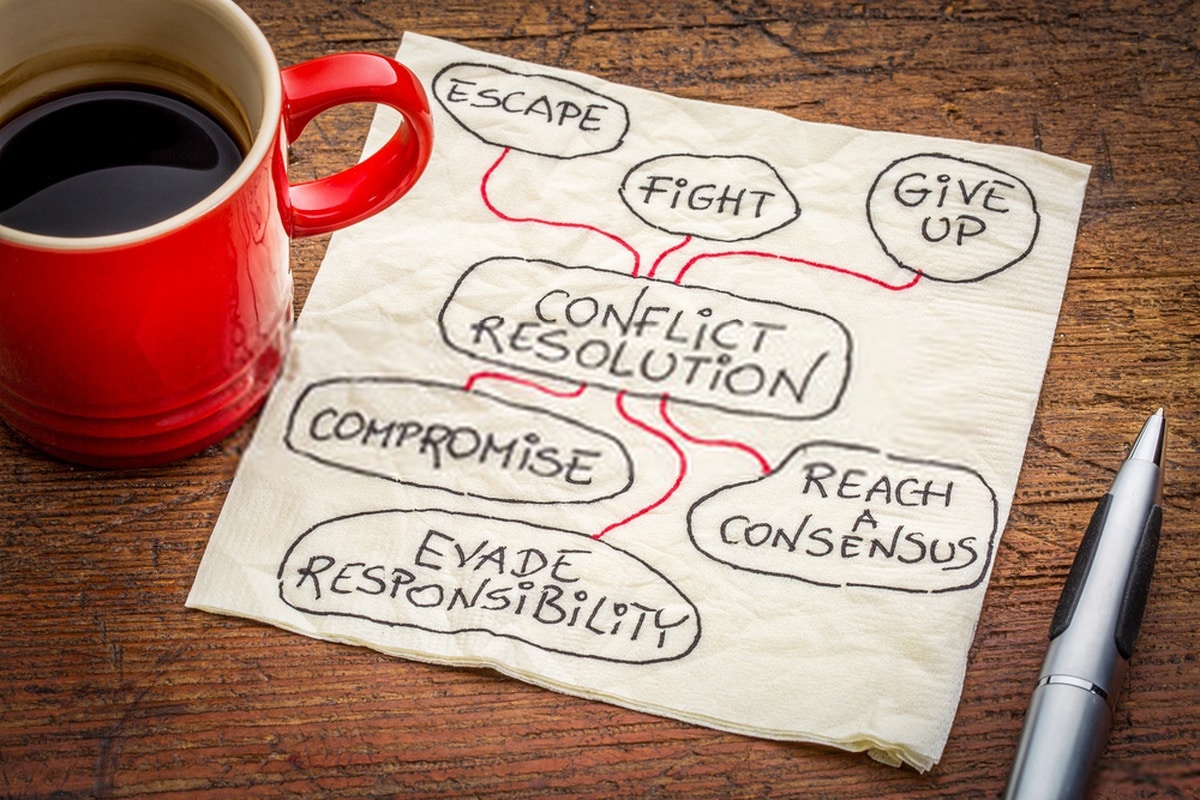Unless you live on a secluded island alone, the chances that you don’t have to deal with conflicts and conflict resolution are almost nil. Conflicts are not always a bad thing, sometimes conflicts lead to better results because you may be able to identify, discuss, and resolve faults in the system. However, an effective approach to conflict resolution is always good.
Most Psychologists agree that conflicts have to be dealt with to prevent deadlock and blame games to restore stability and effective communication. The question is, how? In principle there are six different ways of dealing with a conflict situation:
1. Escape

Escaping is the same as avoiding. The conflict is not dealt with, and the situation remains the same. It can be assumed that neither side will gain anything. This is a lose-lose situation.
The person involved in the conflict situation neither pursues his own concerns nor those of the other individual. Thus he does not directly address the conflict. Avoiding might take the form of diplomatically sidestepping an issue, postponing an issue until a better time, or simply withdrawing from a threatening situation. It is also known as silence mode while dealing with difficult situations.
No matter how unwise this approach may sound, it is indeed effective depending sometimes. If for instance, the situation gets too heated or the other party is emotionally charged up and can’t think rationally, this is the best way to deal with the conflict, only to be addressed later.
2. Fight

Sometimes also called competing. A way to deal with a conflict aggressively with only one objective – to win. One side winning has another fallout, somebody also has to lose. This approach is about winning over the opponent and asserting one’s position in the face of resistance from others. The result is a win-lose situation.
The person involved in the conflict situation is assertive and uncooperative, the individual pushes his concerns at the other person’s expense. This is a power-oriented mode in which you use whatever power seems appropriate to win your own position—your ability to argue, your authority, or your economic position.
Competing means “standing up for your rights,” defending a position that you believe is correct, or simply trying to win.
3. Give up

Those who give up their own position in a conflict solve it by retreating, i.e. they lose. The result is a lose-win situation. Unlike escape where you do not address the concern and the conflict situation remains the same, here you give up your position to let the other parties win.
This is also applicable in cases where your position becomes untenable due to new developments in a conflict situation or when you are confronted with a scenario that makes your position very weak.
4. Evade responsibility

Those who feel overwhelmed by conflict often delegate the decision – and thus also the confrontation – to another authority, usually a higher one. This authority solves the conflict for them, but not necessarily wisely, and not necessarily in the delegator’s interest. There is a risk that the parties on both sides of the conflict will lose (a lose-lose situation).
5. Compromise

Depending on how it is perceived, a compromise is a solution acceptable to both parties. It is often felt that although the solution isn’t ideal, it is reasonable in the circumstances (win-lose/win-lose).
This is most true in cases where each party has a completely opposite position and both are mutually untenable. There is also no way to arrive at a new solution because the solution has no alternative.
For example, in a project, two key stakeholders have to fill the position of technical specialist and both have a candidate in mind. IF only these two candidates are qualified for this position, one stakeholder has to give up his recommendation.
6. Reach a consensus

A consensus involves arriving at a mutual and often new solution that has been worked out by all the parties involved. In contrast to a compromise, it is a win-win situation for both parties, because nobody has to back down. Instead, both parties develop a ‘third way’ together.
In the example of the two stakeholders recommending their own candidate to fill up the position of technical specialist, if there exists a third candidate, they can go ahead and agree to his appointment if mutually agreed and arrived at a consensus.
By understanding the six different responses to conflict resolution, one can identify which response will work in his/her conflict situation. It also helps understand whether that will result in a win or loss for each party involved. An organized way of thinking and addressing conflict scenarios goes a long way in preparing the best conflict resolution response. Most often our failures are due not to the defeats we suffer but to the conflicts we don’t participate in.


